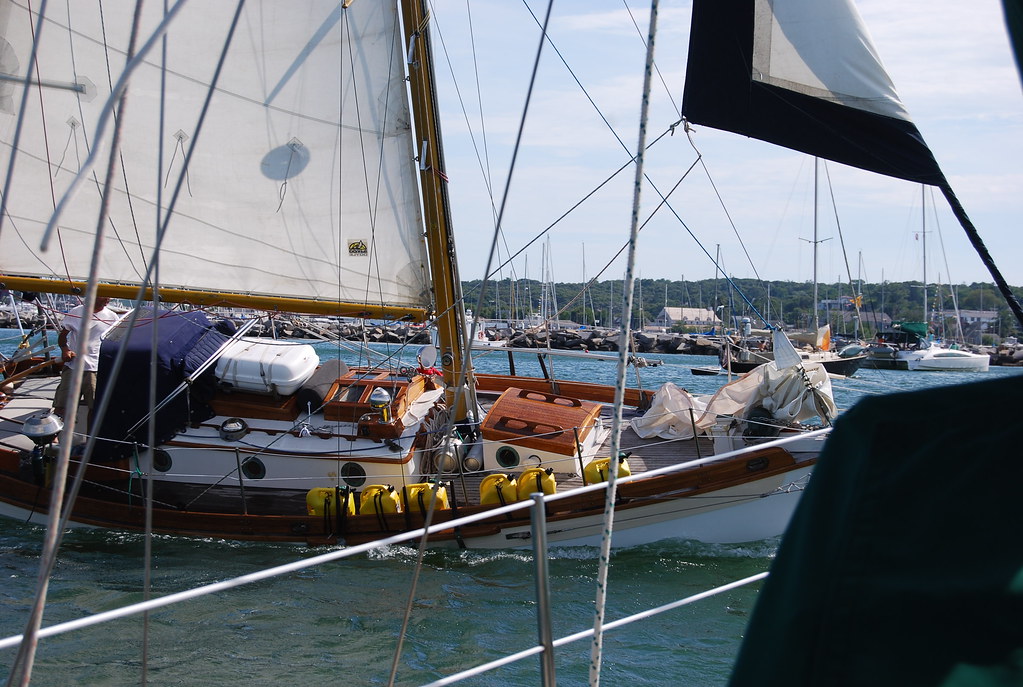Stewart: Hi!
That’s easy. You have to make the mark yourself - the mast doesn’t come with such a mark.
I did the calculations 6 years ago. And the results of the calculation are mentioned in the stability information book I wrote for Zygote (see p. 9 of Zsib.pdf, if you have a copy).
The deal is that:
- you calculate the volume of air which, if trapped in the cabin, can support the displacement of the boat. The nautical engineer whom Sam L Morse Co hired to do the stability calculations for a BCC defined the two reference displacements:
(a) the lightship, minimum operating condition, or arrival displacement, which he defined as 13,607 lbs (6.169 tonnes); and
(b) departure condition (as if going on a voyage, loaded with stores, fuel, water etc), which he defined as 14,327 lbs (6.498 lbs).
-
having calculated the volume of air which would (a) support 13,607 lbs and (b) 14,327 lbs, you then calculate the location of the lower surface of that bubble of air inside the cabin for each of those volumes;
-
and, if you assume (and we all know the danger of assumption) that the boat would stay in fore-aft trim as it sank, you can easily calculate the minimum Freeboard (F subscript m) for each of those two flooding situations.
-
when I ran the figures, I calculated (I live in the metric world, not one that clings to the foot size of King whoever, so be patient while I talk in metres) that F sub m in lightship condition was 0.67 m (ie 640 mm) and for departure condition 0.64 m. Since we’re only talking about a 30 mm difference (ie a bit fatter than 1 inch), we only bother calculating further for departure condition.
The lower surface of the volume of air (if it were trapped inside the cabin) necessary to float the BCC in departure condition occurs (according to my calculations) occurs at an F sub m of 0.33 m. (I’ve probably got the spreadsheet that did the work, but finding it would likely take longer I’ve spent typing this)
- With the boat in either lightship or departure condition (or in whatever condition of load with which you are comfortable), you make a mark on the mast to represent the current waterline. Let’s say you have your boat loaded such that its displacement is 14,327 lbs and your F sub m is 0.64 metres (ie you take a tape measure and run it over the distance from the water to the point where the deck is the lowest above the water). You make a mark on the mast, eg a blob of blue paint in the groove track, where the plane of the waterline would cut it. That’s your first internal reference point.
If you accept my calculation that the air trapped inside the cabin will not float the boat if Freeboard is less than 0.33 m, you just do the sum 0.64 - 0.33 = 0.31 m and measure 310 mm above your first reference mark. And daub red paint there in the groove track.
Then you get used to seeing the red mark. You get a feeling for about what proportion of the cabin + forepeak + engine room volume is above the plane represented by the red mark.
That would allow you, given that the boat when sinking it likely will trim bow down, stern down, or listed to one side, to judge that same safety margin of just how much water can be tolerated inside the boat.
As you can imagine, I’ve not put my calculation of minimum Freeboard to test. But neither have I tested that the point of vanishing stability is at 133 degrees heel.
But I get a bit of fun, when we have land lubbers on board, pointing out once they are comfortable sitting on the settee when we’re still in the marina berth, that their feet and lower legs are below the waterline. And that the red mark is the marker of when it’s time to start counting 8 minutes (because that’s how long, based on experience in a relatively calm swimming pool, it takes to inflate the life raft and scramble on board when clothed. It’s not easy. I figure it would take longer in genuine ocean abandon ship conditions).
Cheers
Bil
